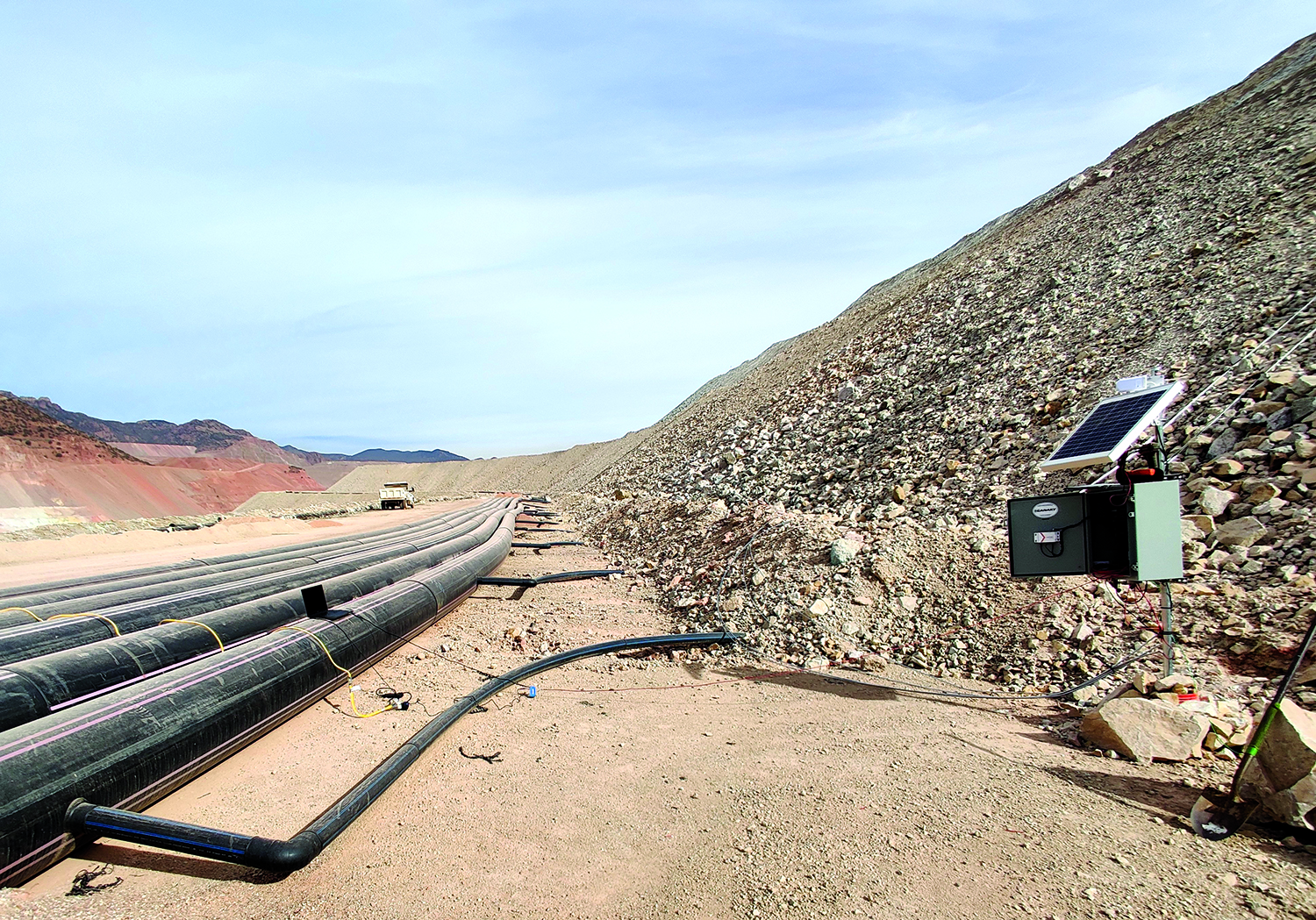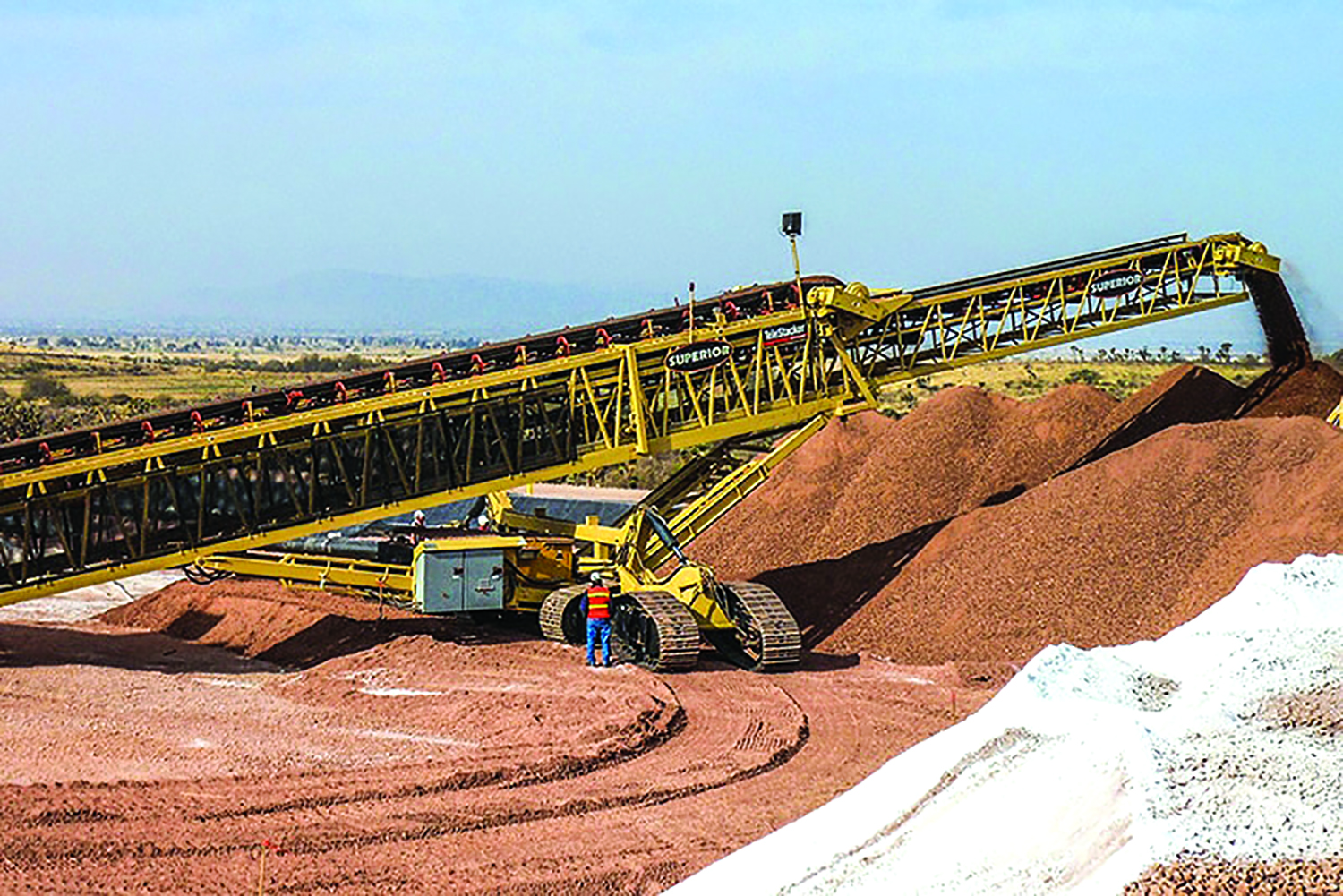
MLRemotes installed around a heap leach gather data and send it to a datalogging gateway, called the MLBase (above), which can connect directly to a mine site’s network. (Photo: Canary Systems)
Design and process visualization become more important as leaching gains in popularity
By Steve Fiscor, Editor-in-Chief
Heap leach pads provide payback over time. The mines crush the ore and place it on an engineered pad. Depending on the metal that’s being recovered, a solution of either cyanide for gold or sulphuric acid for copper is irrigated onto the pile and allowed to percolate through it. The metals are extracted in solution and recovered.
Like most mining projects, design and scale are important. The linings and the supporting infrastructure need to be installed properly because it will soon be buried and flooded with solution. A large pad would theoretically provide more metals over time, however, recovery rates can vary, depending on a number of factors, such as the grade of the ore, the consistency of the grind and how the lifts are stacked, among others. A larger pad requires more materials and time to build, which pushes that payback farther out on the timeline.
Over the years, metallurgists have speculated about what’s actually happening inside the pile. Today, sophisticated sensors and modeling systems are substantiating their suspicions about heat, oxidation rates and recovery rates.
Monitoring the Heap Leach Process
To help better understand the leaching process, what’s taking place inside the heap, and the stability of the pile, Canary Systems has designed a data collection and integration system, which includes rugged sensors, dataloggers, and MLSuite, a Web-based data suite, to capture and present the data in a useful format. The company has installed one system at a copper leaching operation, and they are currently conducting a trial at another copper mining operation.
With heap leach systems, Canary Systems focuses its data integration efforts in two main areas: the production efficiency side, using the oxygen sensors, and the slope stability side, integrating an array of in-ground and remote sensing technologies. Data from both sources are combined in a user interface, called MLWeb.
“We monitor both gaseous and dissolved oxygen content using PreSens Oxybase sensors that we have integrated with our stations,” said Will Conrad, technical specialist for Canary Systems. “It helps the users determine how well the mineral-bearing solution is being extracted from the heap leach.” Data on heat and oxygen, or the lack thereof, recorded over time can help users better understand oxidation rates within the heap.
The sensors themselves are designed to withstand the arduous conditions they would encounter. “Within the pile, they are buried and submerged in hot, low pH (acidic) solution for long periods of time,” Conrad said. “The temperature sensors rely on thermistors to measure heat.”
The mines typically use a sonic drill to drive a borehole through the rubbelized material. “The sensors are inserted into the borehole, and we are able to install multiple sensors in each hole at different levels with bentonite backfill to isolate targeted areas,” Conrad said. “The sensors are wired, and the cable needs to be rugged as well, especially if it’s a leach heap under active construction where the borehole and cable may eventually be buried. For the cabling, we have designed a back shell to connect the sensors to the cable and protect them. Some of these sensors are placed at a depth of 200 ft, with the cable then routing up to 1,000 ft away to connect to a data logging and communications station outside of any active construction.
The systems Canary Systems provides range from robotic total stations, GNSS sensors, and extensometers. “The type of solutions implemented depends on what the mine requires to manage their risk,” Conrad said. “The pile must be established in a safe manner and every effort should be made to make sure that it has no underlying issues.”
“The object is to see if and where materials are moving, long before issues arise, to be able to react appropriately to prevent any incidents,” he said.
“We can provide a high level of accuracy with our MLGPS product,” Conrad said. “GPS sensors are placed around the crest and the slope. The units have their data corrected for variable atmospheric effects with a stable reference station. The data from those long-term remote monitoring points are averaged over time, usually from 15 minutes to 24 hours, depending on how reactive the mine needs to be to potential movement. There’s a tradeoff here between having more timely data to react to, versus having higher accuracy with longer solutions.”
The MLRemote sensors are programmed to record and report the data at predetermined intervals. This eliminates the need for a technician to record and download data from each of the sensors. They have long-lasting batteries, and they can also communicate over radio frequency back to a public or private network, where data can be further integrated into the MLWeb platform. “The MLRemotes installed around a heap leach gather data and send it to a data logging gateway, called the MLBase, which can connect directly to a mine site’s network,” Conrad said.

Nearly 11 million ft2 of HDPE liner was installed on this leach pad. (Photo: AGRU America)
Canary Systems’ MLWebHardware consists of a browser-based logger configuration application. “Previously, users would log into a PC or server where the tools were installed,” Conrad said. “With MLWebHardware, the user can log into the software from anywhere if they can access the network where the software is installed. It provides more access and flexibility. Once the hardware is configured and all the loggers are talking back to the system, the data is then transferred to the MLWeb component. The dashboard allows the users to generate reports and set alarms.”
It also provides browser-based data analysis tools and 3D visualization, right at the user’s fingertips. While the copper mine has been using the complete MLSuite solution for more than a decade now, Conrad said the oxygen monitoring sensor integrations are relatively new. He has been impressed with how well they have performed and withstood the harsh heap leach conditions for more than two years.
Containment Systems
When it comes to containment systems for heap leach facilities, liner selection is important. Liners need to be durable enough to withstand rips and punctures, yet pliable enough to work with. Geosynthetics are a popular choice these days. Made from polymer materials, they are available in many forms and configurations, and they can easily be welded to prevent leaks.
AGRU America offers geosynthetic products for heap leach and other mining-related containment systems. The company’s high-density polyethylene (HDPE) geomembrane liners have a resin coating that resists degradation.
In a case study, the company discussed a liner system that was installed for a large heap leach facility in northern Nevada. AGRU supplied more than 12.2 million ft2 of HDPE Liner for the leach pad and process pond. The company manufactured 80 mil HDPE double-sided MICROSPIKE, with about 10.8 million ft2 going toward the new heap leach pad.
Because the existing pad was reaching full capacity, the mine set an aggressive schedule for completing the new pad. The contractor and installers worked with large crews, AGRU explained, to accommodate the schedule. The company met the mine’s goals and attributed the success to the liner’s smooth edge seams that it said helped streamline installation.

Automated heap leach conveying systems that are programmed to stack per desired lift specifications. (Photo: Superior Industries)
Stacking Consistently
Heap leach pads require highly mobile and flexible material handling equipment. More operations are using integrated conveyor systems, which can be custom-engineered for a specific pad design.
Superior Industries offers automated heap leach conveying systems that are programmed to stack per desired lift specifications. At the core of the system is the company’s TeleStacker System, which is engineered with an internal stinger conveyor that maintains constant motion along a cell, distributing material evenly to achieve a flat top, while also piling more material per move.
The conveyor is equipped with the FD Series Axle assembly, a technology that allows a quick transition from radial to linear mode, enabling movement along the leach pad’s centerline. The system also features the FB Undercarriage support system, which is constructed of durable steel and a tubular braced structure that prevents any twisting and shifting. This level of stability is required for uneven ground and the constant movement typically seen in the heap leach environment, according to Superior.
Some operations use radial travel tracks and/or a track-mounted mobile pivot base in conjunction with the telescoping conveyor. The radial travel tracks, according to Superior, are a cost-effective method to gaining optimum flotation and traction.




